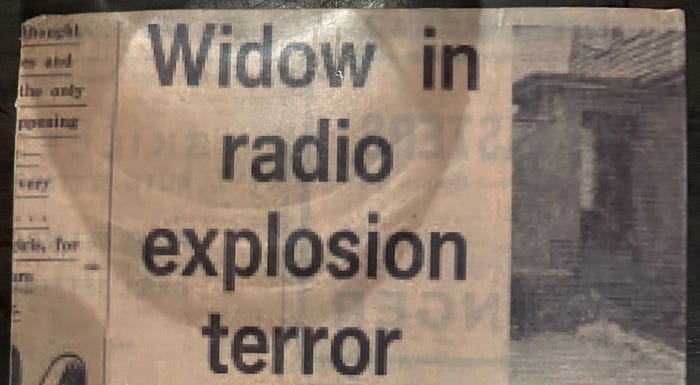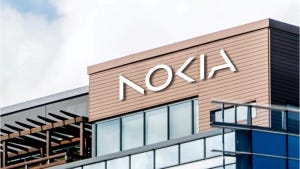Three shows off UK open RAN 'blueprint' with Glasgow small cells
Open RAN technology could help Three manage across multiple radio vendors, the operator's CTO says as the company begins a small cell rollout in Glasgow.

"Widow in radio explosion terror," reads an old Scottish newspaper headline on the back of a laminated menu for The Citizen, a restaurant in Glasgow where Three this week met reporters. The smallest of the UK's four mobile network operators has seen a less dangerous kind of explosion on its own radios since 5G services were launched in 2019. The average customer now chomps through about 30 gigabytes a month, double the level seen by other networks, according to Iain Milligan, Three's chief network officer. "It is huge, huge levels of consumption," he said.
Three's 5G network today covers about 62% of the population, but expansion stopped in late 2022. "The big reason for that is the cost of deploying 5G is huge, and there are lots of other things to be focusing on," said Milligan. Besides ripping out Huawei's equipment under government orders (it must be gone by the end of 2027), Three has started to add 5G sites in populated areas to cope with that data explosion. Another 500 are planned this year on top of the roughly 5,500 it currently maintains. And small cells, designed to boost capacity in urban hotspots, could be an economical answer, Milligan believes.

Not what you normally see on a restaurant menu.
The other challenge he faces is a mishmash of radio access network (RAN) vendors. Three has more RAN suppliers in its network than any rival, having started with Nokia in 3G and used Samsung when it rolled out 4G (there are still 7,000 Samsung sites). Three chose Huawei as its 5G vendor before a government ban was imposed and it began switching to Ericsson. Managing four different vendor systems is more complicated and costly than dealing with just one.
But a new project in Glasgow could help with 5G densification and vendor management in the future. Instead of building whole new macro cell sites at great expense, Three is putting small cell equipment on lampposts and similar street furniture rented from Boldyn Networks, a company that leases passive infrastructure to operators. The RAN equipment does not come from one of Three's four existing vendors, but rather a US supplier called Mavenir. By March, Three plans to have switched on the first of 20 phase one sites. And over the next 15 months, it hopes to install 51 in total across Glasgow's city center. If successful, the project could be a "blueprint" for 5G rollout in other UK cities, said Milligan.
'Beholden to one vendor'
The initiative has been framed by Three as evidence of its interest in "open RAN," a push for new interfaces allowing a telco to combine products from different suppliers at the same mobile site. Like many of his industry peers, Milligan is dissatisfied with the status quo that always forces him to buy a pre-integrated system from a single big vendor. "There is a need to look at a way of changing up that mix so we are not fully beholden to one vendor," he told reporters gathered at Glasgow City Chambers to hear about the plans. "When you take Ericsson, you're in with Ericsson. When you take Nokia, you're in with Nokia."
Open RAN enthusiasm will appeal to the UK government, which sees the concept as an important spur to vendor diversity after its Huawei ban. By 2030, it wants 35% of network traffic to be carried over open RAN infrastructure (although it is not forcing operators to reach this level). But Milligan clearly deems that unrealistic, saying "another big swap-out to hit an open RAN target isn't really effective."
In the case of the Glasgow small cells project, moreover, the two most important components – the radios and the baseband software – come from Mavenir. Critics would say this makes it open RAN in name only, assuming the open fronthaul interface is fully compatible with the specifications drawn up by the O-RAN Alliance, a telco-led industry group. In a "true" open RAN, the vendors on either side of that interface are different, said Nokia CEO Pekka Lundmark during the Finnish vendor's last quarterly earnings call with analysts.
Ideally, Milligan would like to use Mavenir's software in conjunction with radios provided by his big suppliers. Three has installed the central and distributed units hosting Mavenir's software in local exchanges and bigger data facilities, of which it now maintains 19 across the UK. This leaves only radio equipment at the small cell, minimizing rollout and maintenance costs, especially if any Scots go on a mast-vandalizing rampage. Such rearchitecting promises savings. And with "virtualization," which unites Mavenir's software with general-purpose hardware, Milligan ultimately hopes to put RAN computing on the same private cloud platform as the 5G core and realize further efficiency benefits.
Multivendor mayhem
Macro sites already up and running are not compatible with the open fronthaul specification, however. In Glasgow, that means the interoperability focus is largely on X2, an interface that supports handover from one cell to another. Ericsson, Huawei, Nokia and Samsung are all present in Three's Glasgow network. With Mavenir joining the mix, Three will not want customers to lose connections when they move around.
Nevertheless, multivendor rollouts combining Mavenir's software with third-party radios could potentially follow in other cities, depending on what Three learns in Glasgow. "One of the tests that we do here is to see how flexible it really is, how flexible is the software and how well it works with other components," said Milligan.
To support future planning, Three has also involved a network analytics company called PI Works in the Glasgow project. "It takes all the radio data and configuration data and actually starts to identify failure points or inefficiencies where spectrum has been used," said Milligan. Importantly, PI Works can also be unleashed on a multivendor network. A comparable self-optimizing network (SON) system from Ericsson works only with the Swedish vendor's technology, according to Milligan.
Now highly regarded by some telcos, Mavenir's radios will provide a much needed boost for Glaswegian customers of Three, insists the operator. It is loaded with "midband" spectrum, having scooped frequencies during a government auction and earlier takeover activity. And Mavenir was the only vendor whose radios could bring 140MHz rather than just 120MHz into play, according to one Three executive.
Unclear is what impact a planned merger with Vodafone would have on these small cell moves. Three and Vodafone both say they do not cover their costs as standalone players in the UK market, and Milligan's argument about capital expenditure constraints and the need to find economical alternatives supports the company line. But priorities may rapidly shift if the deal to unite two networks, each comprising roughly 18,000 sites, is allowed by UK authorities. In the meantime, neither telco can afford to stand still.
Read more about:
EuropeAbout the Author(s)
You May Also Like












